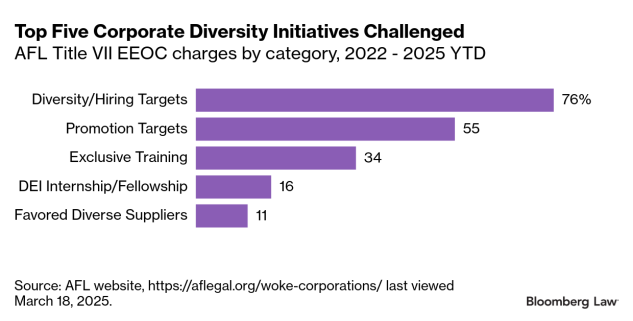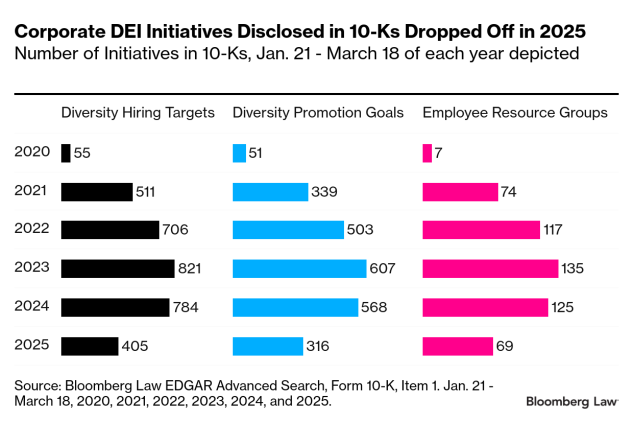Prior to Jan. 20, corporate diversity initiatives were on life support. However, an even heavier blow to corporate DEI fell on Jan. 21, when President Donald Trump issued Executive Order (EO) 14173, which encourages companies to vacate diversity initiatives and also directs federal agencies to “combat illegal private sector DEI preferences, mandates, policies, programs, and activities.”
Companies—especially federal contractors like Booz Allen Hamilton—immediately complied with the order. (A February federal court ruling temporarily halted the private sector anti-DEI provision of the EO but the EO was allowed to proceed after an appeals court awarded a stay of the injunction in March.)
This year’s DEI policy reversals come on the heels of the numerous voluntary corporate DEI rollbacks that happened in 2024 and that I predicted would continue into 2025.
My analysis of EEOC charges and 10-K filings in recent years shows that diversity hiring and promotion goals would likely qualify as “illegal DEI” under the Trump administration, and that companies are erasing these initiatives from their corporate filings.
Defining ‘Illegal DEI’ Post-EO
Private sector “illegal DEI” has yet to be clearly defined. Yet clues can be drawn from legal attacks against corporate DEI in recent years.
Campaigns targeting these initiatives have come from many sources, including an incoming presidential administration that rigorously campaigned on dismantling corporate DEI, social media campaigns aimed at DEI, anti-diversity litigation, and EEOC claims.
Data gleaned from EEOC charges brought by DEI opponent American First Legal (AFL)—founded by White House Deputy Chief of Staff Stephen Miller—shows what might be considered “illegal DEI” today. AFL’s claims against corporate DEI measures have led to numerous EEOC charges. These claims most often argue that companies violate Title VII of the Civil Rights Act when their corporate diversity initiatives allocate exclusive resources to certain racial and gender groups.
AFL has filed EEOC charges against companies including Williams Sonoma Inc., Smithfield Foods Inc., McDonald’s Corp., Nike Inc., Hasbro Inc., United Airlines, Kellogg’s Co., and The Hershey Co. More than three-fourths of the companies have hiring targets that AFL claims are discriminatory.
Diversity hiring and promotion targets are company goals to both hire and promote a target number of employees who self-identify as a specific race, ethnicity, gender, or underrepresented minority group.
More than half of the companies have promotion targets that AFL has challenged. Many companies such as PepsiCo, Bank of America, or Citigroup have withdrawn their corporate diversity initiatives after Trump issued the EO.
Diversity Hiring, Promotions, Employee Groups Fall
My comparison of Form 10-K filings submitted in the eight weeks since Trump signed the EO to historical filing data from the same time period in the past five years reveals a marked drop in the number of DEI disclosures. From Jan. 21 to March 18, the number of three types of DEI initiatives dropped by about half from their peak for the same time period in 2023.
It stands to reason that the severe and rapid decline in corporate diversity goals reporting is because of the EO. Companies initiated many of these goals after George Floyd was murdered by a police officer in 2020. The number of corporate DEI disclosures on Form 10-Ks skyrocketed in 2021, with a sustained increase in the following years until 2024, when the numbers declined moderately.
Trump’s anti-DEI order and rhetoric has had a marked impact on corporate behavior. Companies are deciding to proactively remove corporate diversity programs—as demonstrated by Form 10-K filings—before any major federal investigation or litigation occurs. This corporate 180 on DEI has been swift and significant, and there will likely be deeper cuts to corporate programs in the months to come.
Bloomberg Law subscribers can find a variety of Practical Guidance documents, workflow tools, and reference materials for corporate counsel in our Corporate Practice Center resource and our In Focus: Executive Orders & Actions page.
If you’re reading this on the Bloomberg Terminal, please run BLAW OUT in order to access the hyperlinked content or click here to view the web version of this article.
To contact the reporter on this story:
To contact the editor responsible for this story:
Learn more about Bloomberg Law or Log In to keep reading:
See Breaking News in Context
Bloomberg Law provides trusted coverage of current events enhanced with legal analysis.
Already a subscriber?
Log in to keep reading or access research tools and resources.


